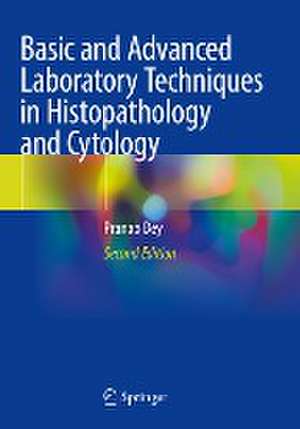Basic and Advanced Laboratory Techniques in Histopathology and Cytology
Autor Pranab Deyen Limba Engleză Paperback – 12 ian 2024
The book's second edition covers several important recent topics with many new chapters, such as liquid biopsy, artificial neural network, digital pathology, and next-generation sequencing.
Each chapter elucidates basic principle, practical methods, troubleshooting, and clinical applications of the technique. It includes multiple colored line drawings, microphotographs, and tables to illustrate each technique.
The book is a helpful guide to the post-graduate students and fellows in pathology, practicing pathologists,as well as laboratory technicians, and research students.
| Toate formatele și edițiile | Preț | Express |
|---|---|---|
| Paperback (2) | 662.70 lei 39-44 zile | |
| Springer Nature Singapore – 12 ian 2024 | 662.70 lei 39-44 zile | |
| Springer Nature Singapore – 10 ian 2019 | 671.16 lei 39-44 zile | |
| Hardback (1) | 1053.82 lei 3-5 săpt. | |
| Springer Nature Singapore – 2 ian 2023 | 1053.82 lei 3-5 săpt. |
Preț: 662.70 lei
Preț vechi: 697.58 lei
-5% Nou
Puncte Express: 994
Preț estimativ în valută:
126.84€ • 131.92$ • 106.29£
126.84€ • 131.92$ • 106.29£
Carte tipărită la comandă
Livrare economică 10-15 martie
Preluare comenzi: 021 569.72.76
Specificații
ISBN-13: 9789811990977
ISBN-10: 9811990972
Pagini: 340
Ilustrații: XXIX, 340 p. 216 illus., 212 illus. in color.
Dimensiuni: 178 x 254 mm
Ediția:2nd ed. 2022
Editura: Springer Nature Singapore
Colecția Springer
Locul publicării:Singapore, Singapore
ISBN-10: 9811990972
Pagini: 340
Ilustrații: XXIX, 340 p. 216 illus., 212 illus. in color.
Dimensiuni: 178 x 254 mm
Ediția:2nd ed. 2022
Editura: Springer Nature Singapore
Colecția Springer
Locul publicării:Singapore, Singapore
Cuprins
Chapter 1: Fixation of histology samples: Principles, methods and types of fixatives.- Chapter 2: Processing of tissue in the histopathology laboratory.- Chapter 3: Embedding of tissue in histopathology.- Chapter 4: Decalcification of bony and hard tissue for histopathology processing.- Chapter 5: Tissue Microtomy: principle and procedure.- Chapter 6: Frozen section: Principle and procedure.- Chapter 7: Staining principle and general procedure of staining of the tissue.- Chapter 8: Haematoxylin and Eosin stain of the tissue section.- Chapter 9: Special Stains for the carbohydrate, protein, lipid, nucleic acid and pigments.- Chapter 10: Connective tissue stain: Principle and procedure.- Chapter 11: Amyloid staining.- Chapter 12: Stains for the Microbial Organisms.- Chapter 13: Cytology sample procurement, fixation and processing.- Chapter 14: Routine staining in cytology laboratory.- Chapter 15: The basic technique of fine needle aspiration cytology.- Chapter 16: Immunocytochemistry in histology and cytology.- Chapter 17: Flow cytometry: Basic principles, procedure and applications in pathology.- Chapter 18: Digital pathology.- Chapter 19: Automation in the laboratory and Liquid-based cytology.- Chapter 20: Polymerase chain reaction: Principle, technique and applications in pathology.- Chapter 21: Fluorescent in situ hybridisation techniques in pathology: Principle, technique and applications.- Chapter 22: Tissue microarray in pathology: Principal, technique and applications.- Chapter 23: Sanger sequencing and next-generation gene sequencing: Basic principles and applications in pathology.- Chapter 24: Liquid biopsy: Basic principles, techniques and applications.- Chapter 25: Artificial neural network in Pathology: Basic principles and applications.- Chapter 26: Compound Light microscope and other different microscopes.- Chapter 27: Fluorescence microscope, confocal microscope and other advanced microscopes: Basic principles and applications in pathology.- Chapter 28: Electron microscopy: Principle, components, optics and specimen processing.- Chapter 29: Quality control and laboratory organization.- Chapter 30: Laboratory safety and laboratory waste disposal.- Multiple choice questions for the self-assessment.
Notă biografică
Pranab Dey is professor in department of cytology and gynecologic pathology at Post Graduate Institute of Medical Education and Research (PGIMER), Chandigarh, India. Professor Dey completed M.D. (Pathology) from PGIMER and FRCPath (Cytopathology) from Royal College of Pathologist, London, UK. Professor Dey has conducted many research projects and has pioneered works on DNA flow cytometry, image morphometry, mono-layered cytology and cytomorphologic findings of various lesions on cytology smears. Professor Dey has more than 35 years of experience in reporting, teaching and research as a consultant. He is a well published author in pathology and a member of various societies. He has more than 450 research paper publications in peer-reviewed journals. He has authored 12 books in cytology and gynecologic pathology. Dr Dey is included in the list of top 2% scientists in the world.
Textul de pe ultima copertă
The second edition of this well-received book provides detailed information on the basic and advanced laboratory techniques in histopathology and cytology. It offers clear guidance on the principles and techniques of routine and special laboratory techniques. It also covers advanced laboratory techniques such as immunocytochemistry, flow cytometry, liquid-based cytology, polymerase chain reactions, tissue microarray, molecular technology, etc.
The book's second edition covers several important recent topics with many new chapters, such as liquid biopsy, artificial neural network, digital pathology, and next-generation sequencing.
Each chapter elucidates basic principle, practical methods, troubleshooting, and clinical applications of the technique. It includes multiple colored line drawings, microphotographs, and tables to illustrate each technique.
The book is a helpful guide to the post-graduate students and fellows in pathology, practicing pathologists, aswell as laboratory technicians, and research students.
The book's second edition covers several important recent topics with many new chapters, such as liquid biopsy, artificial neural network, digital pathology, and next-generation sequencing.
Each chapter elucidates basic principle, practical methods, troubleshooting, and clinical applications of the technique. It includes multiple colored line drawings, microphotographs, and tables to illustrate each technique.
The book is a helpful guide to the post-graduate students and fellows in pathology, practicing pathologists, aswell as laboratory technicians, and research students.
Caracteristici
Covers updated information on both the basic and advanced laboratory technology Includes a separate chapter on multiple-choice questions for self-assessment Provides comprehensive and easy to follow details with a step-wise approach
